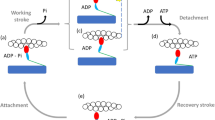Abstract.
The present model of the motoneuronal (MN) pool – muscle complex (MNPMC) is deterministic and designed for steady isometric muscle activation. Time-dependent quantities are treated as time-averages. The character of the model is continuous in the sense that the motor unit (MU) population is described by a continuous density function. In contrast to most already published models, the wiring (synaptic weight) between the input fibers to the MNPMC and the MNs (about which no detailed data are known) is deduced, whereas the input–force relation is given. As suggested by experimental data, this relation is assumed to be linear during MU recruitment, but the model allows other, nonlinear relations. The input to the MN pool is defined as the number of action potentials per second in all input fibers, and the excitatory postsynaptic potential (EPSP) conductance in MNs evoked by the input is assumed to be proportional to the input. A single compartment model with a homogeneous membrane is used for a MN. The MNs start firing after passing a constant voltage threshold. The synaptic current–frequency relation is described by a linear function and the frequency–force transformation of a MU by an exponential function. The sum of the MU contraction forces is the muscle force, and the activation of the MUs obeys the size principle. The model parameters were determined a priori, i.e., the model was not used for their estimation. The analysis of the model reveals special features of the activation curve which we define as the relation between the input normalized by the threshold input of the MN pool and the force normalized by the maximal muscle force. This curve for any muscle turned out to be completely determined by the activation factor, the slope of the linear part of the activation curve (during MU recruitment). This factor determines quantitatively the relation between MU recruitment and rate modulation. This property of the model (the only known model with this property) allows a quantification of the recruitment gain (Kernell and Hultborn 1990). The interest of the activation factor is illustrated using two human muscles, namely the first dorsal interosseus muscle, a small muscle with a relatively small force at the end of recruitment, and the medial gastrocnemius muscle, a strong muscle with a relatively large force at the end of recruitment. It is concluded that the present model allows us to reproduce the main features of muscle activation in the steady state. Its analytical character facilitates a deeper understanding of these features.
Similar content being viewed by others
Explore related subjects
Discover the latest articles and news from researchers in related subjects, suggested using machine learning.Author information
Authors and Affiliations
Additional information
Received: 24 November 1997 / Accepted in revised form: 30 November 1998
Rights and permissions
About this article
Cite this article
Studer, L., Ruegg, D. & Gabriel, JP. A model for steady isometric muscle activation. Biol Cybern 80, 339–355 (1999). https://doi.org/10.1007/s004220050530
Issue Date:
DOI: https://doi.org/10.1007/s004220050530




